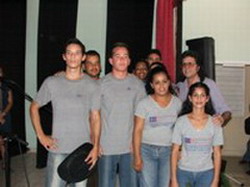In Cuba: Culture Within and For the Community
- Submitted by: admin
- Arts and Culture
- Caribbean
- culture an traditions
- Destinations
- Education
- Entertainment
- history
- national
- personalities
- Society
- Politics and Government
- 10 / 16 / 2008

that the exchange takes place where it first emerged: in the neighborhood, on the street or in the home of any humble Cuban family.
Such a wonderful experience, which is very common here in Cuba, took place recently at the Oya Temple, located on Cristina Street in Havana, roughly 3 blocks away from the Cuatro Caminos farmers market.
There, on the very busy urban thoroughfare, neighbors and passers-by converged spontaneously to appreciate a theater-worthy show, free from sequins and glitz, but rich in good clean fun and commitment.
There, the idea of renowned Cuban ethnographer Fernando Ortiz takes on special significance, when he said that “Cuba’s true history is that of a profound, complex cross-cultural process.” White and black people,
Chinese people and persons of mixed races -- all fully enjoyed the cultural activity on Cristina Street.
Experienced artists like the group ‘Cuatro Vientos’, belonging to the agency Caricato of the National Association of Cuban Writers and Artists (UNEAC) and made up of four musicians, played their handmade traditional
musical instruments -- bata drums, cowbells and wood blocks -- and sang Yoruba songs dedicated to deities of African origin.
The main attraction though was a new group called Proyecto Demelé, which belongs to the community cultural center of the municipality of La Lisa, Mariano. Members of the group played, sang and danced Dahomey
cultural rhythms, barely known to Cubans, in Creole language.
Made, the group’s lead dancer and singer, explained that the music derived from Haiti’s Vudu religion, in which four major languages are mixed: French, American English, native and Creole.
The artists performed and danced in a small area, two to three meters-long. Traffic didn’t stop on the free, clear road. Dozens of people, residents and passers-by alike, applauded after each performance. Some busses
stopped shortly for passengers to enjoy the show.
What happened there in roughly two-and-a-half hours, thanks to the Temple’s director Nancy Pullés Méndez, was well worth the experience. It certainly enriched us all spiritually.
The cross-cultural phenomenon without neon lighting or curtains, the sunlight and our hearts were just enough. As Cuban National poet Nicolás Guillén rightly said: “I’m also a grandson, great-grandson,
reat-great-grandson of a slave (the slaveowner should be ashamed of himself).
(Cubarte)
Comments